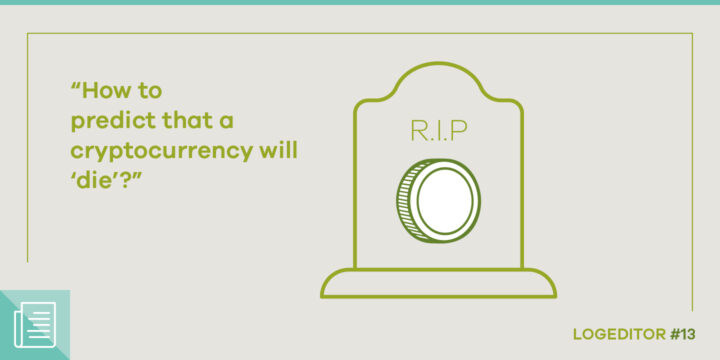
The cryptocurrencies that vanish after telling you to follow them… The ones that are so inadequate, that even their developers have abandoned them… Platforms regarding the habit of delisting…
LogEditor
Finix Coin, Acco Coin, Add Token, Apecoin, Wincoin, and many more…
Have you ever heard about these cryptocurrencies?
Let us give you examples based on the first two:
- Finix Coin very recently announced on its official social media account that investors would earn a 15% bonus if they bought FNX. After these posts in 2018, it became one of the many dead coins.
- In 2018, Acco Coin announced to the world to “Follow Acco Coin improvements”. As you can guess, no improvements or news came.
Today, there are more than 1,600 dead coins according to some sources, while others estimate the number to be closer to 1,950. However, it is estimated that the actual number is even higher. To put it another way, these coins no longer have any value.
Is it so hard to issue cryptocurrencies?
As most people know, in 2009, the generation of the first Bitcoin block sparked a great transformation process. Thanks to the acceleration of Bitcoin, alternative cryptocurrencies called “altcoin” emerged. Today, we know that there are more than 10,000 alternative cryptocurrencies.
In reality, it is not hard to issue an altcoin. But the difficult thing is to provide it with improved infrastructure, to develop the right algorithm, to draw a sustainable road map, and to find solutions to any possible problems that people may have.
Bitcoin emerged to propose tangible solutions such as allowing peer-to-peer payment, ensuring decentralization, and preventing manipulations to transactions.
When we take a glance at the successful projects that followed Bitcoin, we see that some of them have aimed to produce smart contracts which run smoothly; others have aimed to eradicate the intermediaries between the advertiser and the user; while the rest have aimed to give a greater voice to the supporters of clubs regarding their issues.
Yes, cryptocurrencies are a lot more than just financial tools with prices that go up and down. They have some functions that often generate a solution to a problem.
Therefore, the durability of a cryptocurrency is a lot more important than whether or not the high price-performance is observed instantly.
How does a cryptocurrency die?
When talking about why some cryptocurrencies have a shorter lifespan…
- Some cryptocurrencies may emerge from malicious intents.
- It is presented to the market, an income is generated and then the developers vanish into thin air. They do not have any serious infrastructure anyway. Either they do not present improvements, do not have teams or road maps, or they are not realistic.
- Developers of some cryptocurrencies are also crushed under the burden of their own undertakings.
- For instance, they may face unpredictable transfer or wallet issues. They are developed in a hasty and technically inadequate manner. Moreover, they also notice that they cannot deliver any improvements. Financial and technological inadequacy spell the death of a coin.
Probably the most interesting part of this story is that such cryptocurrencies find their place on the markets of quite popular platforms, even though it is rather obvious that their existence cannot be maintained.
“Delist” news agency
Well, then how is it possible that cryptocurrencies which are “destined to die a bit too early” find their place on “big” global platforms?
Because the motivation is not protecting the user, but to gain profit. If the only criterion is whether including a cryptocurrency on the market will bring along volume, surely this will lead to misuse.
Incidentally, delists can certainly be performed on a platform; that is to say, a traded cryptocurrency can be removed from the market.
But if we continue to read news regarding delisting, even a lot more cryptocurrencies that are currently dead were once listed on that platform, so the purposes of the platform should be questioned.
“Will my coin live?”
Well, will the cryptocurrency you invested in be durable in the long-term?
How to find an answer to this question is clear:
- For example, research its trading volume and consensus algorithm.
- Find out whether its supply is limited or not and how much its circulating supply is.
- Check whether there have been improvements or not by viewing its GitHub activities.
- Follow its social media channels and check out the relevant contracts and improvements.
- Take a look into its software security and ecosystem structure.
- Check the details of its area of usage.
Doing all this may require stamina and a significant level of technological/financial literacy. However, it is possible to do at least some of these things.
“Delisting is our guilty pleasure”
On the other hand, there is one more alternative, which is to execute transactions on the platforms which list cryptocurrencies by performing this research.
If the platform you prefer pays attention to this and works in a user-driven manner, you can have peace of mind. If the platform evolves only around profit, you may be investing in a cryptocurrency that is at death’s door.
As I have mentioned before, every platform can delist cryptocurrencies; however, when delisting becomes a habit or routine, your preference of platform should be reconsidered.
Events that happened in Turkey last April were a bitter reminder of how vital it is to choose a reliable platform. Knowing in advance that “reliable cryptocurrency” is just as important will prevent similar incidents.
Because the death of a cryptocurrency has a collective effect, taking away the savings of users while vanishing into thin air.
Its death certificate reads:
“The coin is not active. Please get in touch if you think that this is an error.”
Okay, but where and to whom?
Bu içerik en son 26 October 2022 tarihinde güncellenmiştir.
